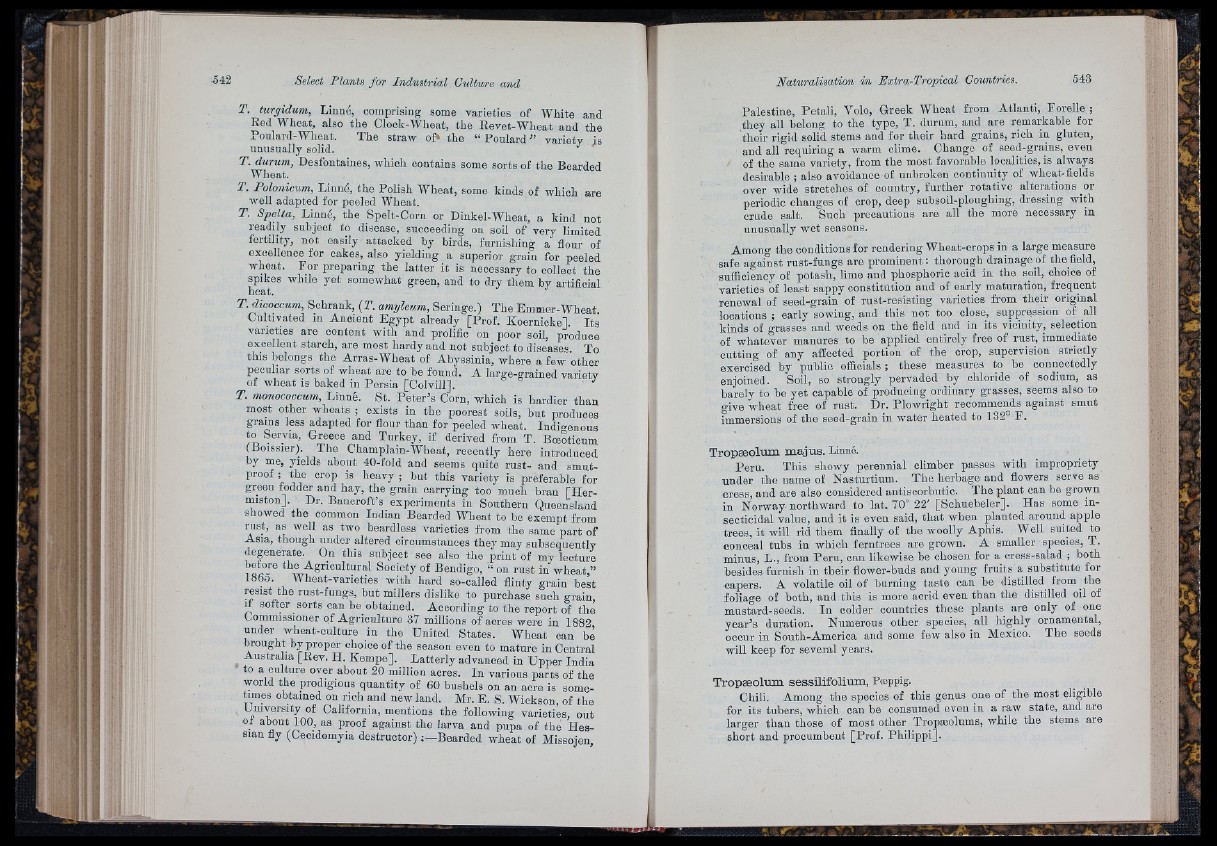
i
• <i
■M
IM
;i- j
i Ï]
T. turgidum, Linné, comprising some varieties of White and
Red Wheat, also the Clock-Wheat, the Revet-Wheat and the
Poulard-Wheat. The straw of* the “ P oulard” variety is
unusually solid.
T. durum, Desfontaines, which contains some sorts of the Bearded
Wheat.
T. Polonicum, Linné, the Polish Wheat, some kinds of which are
well adapted for peeled Wheat.
T. Spelta, Linné, the Spelt-Corn or Dinkel-Wheat, a kind not
readily subject to disease, succeeding on soil of very limited
fertility, not easily attacked by birds, furnishing a flour of
excellence for cakes, also yielding a superior grain for peeled
wheat. For preparing the latter it is necessary to collect the
spikes while yet somewhat green, and to dry them by artificial
neat.
T. dicoccum, Schrank, {T. amyleum, Seringe.) The Emmer-Wheat
Cultivated in Ancient E gypt already [Prof. Koernioke]. Its'
varieties are content with and prolific on poor soil, produce
excellent starch, are most hardy and not subject to disease«. To
this belongs the Arras-Wlieat of Abyssinia, where a few other
peculiar sorts of wheat are to be found. A large-grained variety
of wheat is baked in Persia [Colvill].
T. monococcum, Linné. St. P e te r’s Corn, which is hardier than
most other wheats ; exists in the poorest soils, bnt produces
grains less adapted for flour than for peeled wheat. Indigenous
to Servia, Greece aud Turkey, if derived from T. Boeoticum
(Boissier). The Champlain-Wheat, recently here introduced
by me, yields about 40-fold and seems quite rust- and smut-
proof ; the crop is heavy ; hut this variety is preferable for
green fodder and hay, the grain carrying too much bran [Her-
mistou]. Dr. Bancroft’s experiments in Southern Queensland
showed the common Indian Bearded Wheat to be exempt from
rust, as well as two beardless varieties from the same part of
Asia, though under altered circumstances they may subsequently
degenerate. Cn this subject see also the print of my lecture
before the Agricultural Society of Bendigo, on rust in wheat,”
I 860. Wheat-varieties with hard so-called flinty grain best
resist the rust-fungs, but millers dislike to purchase such grain,
R softer sorts can be^ obtained. Aecording to the report of the
Commissioner of Agriculture 37 millions of acres were in 1882
under wheat-culture in the United States. Wheat can bè
brought by proper choice of the season even to mature in Central
Australia [Rev. H. Kempe]. Latterly advanced in Upper India
to a culture over about 20 million acres. In various parts of the
world the prodigious quantity of 60 bushels on an acre is sometim
e obtained ou rich and new land. Mr. E. S. Wickson, of the
University of California, mentions the following varieties, out
of about 100, as proof against the larva and pupa of the Hessian
fly (Cecidomyia destructor) Bearded wheat of Missojen,
Palestine, Petali, Volo, Greek Wheat from Atlanti, Forelle ;
they all belong to the type, T. durum, and are remarkable for
their rigid solid stems and for their hard grains, rich in gluten,
and all requiring a warm clime. Change of seed-grains, even
of the same variety, from the most favorable localities, is always
desirable ; also avoidance of unbroken continuity of wheat-fields
over wide stretches of country, further rotative alterations or
periodic changes of crop, deep subsoil-ploughing, dressing with
crude salt. Such precautions are all the more necessary in
unusually wet seasons.
Among the conditions for rendering Wheat-orops in a large measure
safe against rust-fungs are prominent: thorough drainage of the field,
sufficiency of potash, lime and phosphoric acid in the soil, choice of
varieties of least sappy constitution and of early maturation, frequent
renewal of seed-grain of rust-resisting varieties from their original
locations ; early sowing, and this not too close, suppression of all
kinds of grasses and weeds on the field and in its vicinity, selection
of whatever manures to be applied entirely free of rust, immediate
cutting of any affected portion of the crop, supervision strictly
exercised by public oifioials ; these measures to he connectedly
enjoined. Soil, so strongly pervaded by chloride of sodium, as
barely to be yet capable of producing ordinary grasses, seems also to
give wheat free of rust. Dr. Plowright recommends against smut
immersions of the seed-grain in water heated to 132° F.
Tropæolum majus. Linné.
Peru. This showy perennial climber passes with impropriety
under the name of Nasturtium. The herbage and flowers serve as
cress, and are also considered antiscorbutic. The plant can be grown
in Norway northward to lat. 70° 22' [Schuebeler]. Has some insecticidal
value, and it is even said, th a t when planted around apple
trees, it will rid them finally of the woolly Aphis. Well suited to
conceal tubs in which ferntrees are grown. A smaller species, T.
minus, L., from Peru, can likewise be chosen for a cress-salad ; both
besides furnish in their flower-buds and young fruits a substitute for
capers. A volatile oil of burning taste can be distilled from the
foliage of both, and this is more acrid even than the distilled oil of
mustard-seeds. In colder countries these plants are only of one
year’s duration. Numerous other species, all highly ornamental,
occur in South-America and some few also in Mexico. The seeds
will keep for several years.
Tropæolum sessilifolium, Poeppig.
Chili. Among the species of this genus one of the most eligible
for its tubers, which can be consumed even in a raw state, and are
larger th an those of most other Tropæolums, while the stems are
short and procumbent [Prof. Philippi].